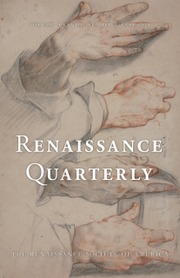The “Renaissance poetry” of Stephen Guy-Bray’s slim but valuable book almost exclusively means “English-language Renaissance Poetry,” even though the study gives valuable insights into the relations between Latin and English, and into some present-day contexts in its last chapter. Divided into the sections “Rhyme,” “Enjambment,” “Sestina,” and “Forwards,” the book, despite its brevity, ranges across wide and sometimes surprising ground, and while the sestina is surely a less usual suspect than rhyme or enjambment, Guy-Bray defends his choice by suggesting that no form “is so uncompromising in its insistence on the endings” (8). He further claims to focus on “line endings that are noticeable and sometimes even obtrusive” (1), which fits well with the self-referentiality and meta-levels that characterize the material.
Of the individual chapters, the one on rhyme moves from the erotic dimensions of especially feminine rhymes in Shakespeare and Marlowe to the relation between good and evil and life and death in Milton; what unites these discussions, claims Guy-Bray, is a focus on how rhyme can be simultaneously expressive of sameness and difference, drawing attention to both the similarity and dissimilarity of two components (22). Chapter 3 similarly emphasizes the ability of enjambment to both conjoin lines and push them apart; here Guy-Bray is also concerned with the semantic senses in which enjambing words connote transgression and movement, and considers how, for example, Golding’s and Sandys’s translations of Metamorphoses relate to the Latin word order, as well as, for example, Thomas Campion’s “extreme enjambments” (44) in splitting up words across lines (which, it could be added, Donne does more than once in his Satires). The chapter on sestina—which obviously draws on a more narrow range of sources—is particularly attentive to the complex interaction of form and content, drawing predominantly on Sidney’s Old Arcadia and queer theory to understand, in a surprising though somewhat underdeveloped turn, how extremely formalist reading can be seen “as queer in itself” (76). The final chapter is not a summation so much as an elaboration on the results of chapters 3 and 4, focusing on a selection of poetry from Auden to more contemporary material (the Americans Robert Creeley, Martha Ronk, and Patricia Smith, and the Australian Stuart Barnes).
Guy-Bray is a highly skilled close reader, as befits his topic, and his book claims to be “for people who read poetry closely and obsessively, who reread, who are distracted by details” (11). This is perhaps an unnecessarily modest-sounding description, as the attention to formal detail is also at the heart of many of the poems Guy-Bray discusses, and his readings themselves are closely attuned to significant themes and content. And while his chapters emphasize attention to individual detail over broad, unifying conclusions, his analyses do have valuable implications for how form relates to content in Renaissance (and a lot of modern) poetry.
Of course, a book of this kind shouldn’t be faulted for leaving the reader wanting more; its narrow focus is a methodological choice, not an omission. But it may still be useful to bear in mind what the author does not address. Guy-Bray suggests that a poem is “a visual artifact as well as a textual one” (2), although in line with his close reading methodology he doesn’t discuss how the physical look of the page—including material factors like paper or ink—affects the interpretation of line endings. Indeed, the validity of his claim that “poems are more often compared to music than to pictures” (2) may depend on where you look (as scholarship on early modern print culture shows). The question of how the voice is embodied on the page (see Jennifer Richards’s recent Voices and Books in the English Renaissance [2019]) is not really addressed, and punctuation, whether early modern or contemporary, receives surprisingly little attention. As for the book’s own form, in a few cases—for example, the discussion of Greville’s “I with whose colors Myra dress her head” (6–8)—the analyses could have benefited from somewhat fuller quotation. And the structure of the chapters can, by the author’s own admission, look “disorderly” (53); however, in the end, Guy-Bray’s discussions come across as wide-ranging and generous rather than rambling.
Even if the author does not suggest so, this is a book that could find its way into classrooms at both graduate and undergraduate levels: it’s compact yet wide-ranging, and while it would have to be supplemented by other material that, for example, considers the physical format of the page (and, perhaps, explains some of the terminology), Guy-Bray’s book testifies to the lasting value and impact of attentive, focused close reading.



